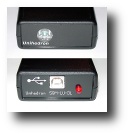Uses:
- Measuring the night sky brightness during remote biological field experiments.
- Find out how good the night or site REALLY is.
- Compare the sky brightness at different sites quantitatively.
- Document the evolution of light pollution in your area.
- Set planetarium dome illumination to mimic the skies people are likely to experience elsewhere in the city.
- Monitor sky brightness through the night, night-to-night, and year-to-year.
- Determine which nights show the greatest promise for finding the 'faintest fuzzies'!
- Calibrate the effect of sky brightness on qualitative measures such as the Bortle Scale.
- Investigate how sky brightness correlates with the solar cycle and month-to-month sunspot activity.
- Help provide local ground truth for future sky brightness prediction with the Clear Sky Clock.
- CCD users can make a correlation between the SQM reading and when the background reaches some ADC level.
|
|
